Croatia has 6 sites listed on the UNESCO World Heritage List, One National Park, two cities, one Cathedral and two complexes.
Historical Complex of Split with the Palace of Diocletian
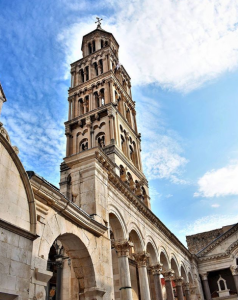
Latin Name: Spalatum – Italian Name: Spalato
Split literally grew out of the palace that the Roman Emperor Diocletian (245-312), a native of the nearby city of Salona, built as what may have been history’s first retirement home. Much of the original structure still remains – both in the form of the original walls and the various buildings constructed out of stone pilfered from it in Split’s Old Town, which the walls encompass. Interestingly, although Diocletian was notorious for his persecution of Christians, the complex includes world’s oldest Cathedral, dedicated to St. Dominius.
Its bell-tower offers wonderful views both over the Old Town and the Adriatic, which once came up to the walls of the palace.
At the end of the 3rd century emperor Diocletian built his palace on the bay of Aspalathos, current day Split, the Palace is one of the the best preserved structures of Roman architecture in the world.
The palace is separated by two main streets into four sections, the southern section was occupied by the emperor whilst the northern section by his servants and guards.
The palace is rectangle in shape it has a large tower in each of the corners and a gate in each of the sides.
The Palace was built using limestone of high quality, the stone was shipped over from the Island of Brac. Some material for decoration were imported Egyptian granite columns and sphinxes.
Old City of Dubrovnik – Dubrovnik
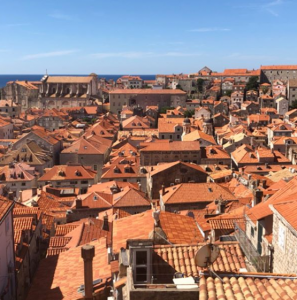
Inscribed 1979, Inscription Extended in 1994
Latin Name: Ragusa – Rausa
Dubrovnik is the greatest fortified city in world, its massive walls stretch 1940 meters fully enclosing the old City of Dubrovnik. Dubrovnik has five fortresses, three are included as part of the surrounding wall, the fortresses in combination with the 25 meters high and up to 6 meters thick walls where the key to the defense of the city against any potential enemies, Turks, Macedonians Venetians etc.
Dubrovnik construction began in the 6th century after the Avars and Slavs overran the present day Cavtat (Epidaurum). the people fled and began building a new settlement on a small rocky island called Laus which later became Ragusa (Rausa). Ragusa was separated from the mainland by a narrow channel.
Across the narrow channel, migrating Slavs started construction of Dubrovnik, In the 12th century the narrow channel was paved and the two towns merged and became Ragusa. The narrow paved channel is the present day main street of Dubrovnik called Placa.
Not only is Dubrovnik one of the world’s most attractive cities – both in its appearance and its location, it’s probably Europe’s best-preserved historic city. It’s entirely pedestrianized and a local ordinance prohibiting signs anywhere but on lanterns outside of shops means that strolling through it on a quiet night you could be forgiven for believing you’d literally been transported back in time. The two kilometers of city walls that enclose it repulsed invaders during the city’s four centuries as an independent republic and again when it came under attack during the early 1990s – today they offer a pleasant means for coming to appreciate this city, the beauty of whose buildings is only matched by that of its location.
Plitvice Lakes National Park

Inscribed 1979, Inscription Extended in 2000
Most visitors to Croatia head for the coast, but if you’re traveling by bus from Zagreb to Split (or even if you’re not) be sure to break up your journey at this system of sixteen interlinked lakes and the park that surrounds them. You can tour the lakes by boat or walk alongside them (which takes anything from five hours to a full day, depending on your level of fitness). The park itself is home to a diverse collection of alpine flora and fauna and is open year-round.
National Park Plitvice – Plitvice Lakes is Croatia’s oldest and best know National Park, 16 emerald green lakes are sprawled across the 20 hectares of bush land linked together by magnificent waterfalls and cascades.
The park is situated between two mountains, Mala Kapela and Pljesivica forming a natural barrier from the extreme temperatures of the coast, just 50KM away, the average temperature is 24 degrees Celsius with a maximum of 36. During winter is is common that the lakes and waterfalls are frozen over, snow is also common.
The park is naturally divided into two sections, the upper and lower lakes, the upper lakes are more impressive, surrounded by dense forest and linked together by large waterfalls.
To preserve the pristine park, wooden walking tracks have been built to enable visitors the close-up experience of the waterfalls and to display the magical variations of colors of the lakes, depending on minerals and organisms in the water and the direction of the sun, the colors can vary from opal green, blue or grey.
Euphrasian Basilica Complex – Porec
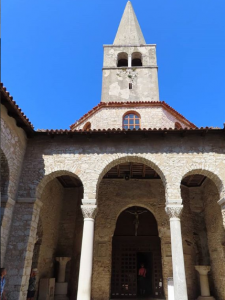
Italian Name: Parenzo
Protected by UNESCO on the basis of its status as the most complete surviving episcopal complex of its type, the sixth century Euphrasian Basilica boasts some of the Europe’s finest mosaics, matched only by their counterparts in Ravenna, which were executed by many of the same artisans. As well as their degree of artistry and preservation, these masterworks are highly enjoyable for their small touches – including the presence of an eavesdropping servant in the mosaic on the right side of the altar and the portrait of the eponymous Bishop Euphrasius himself, believed to be one of the earliest depictions of a living figure in sacred art.
Episcopal Complex of the Euphrasian Basilica in the Historic Centre of Porec
Euphrasian Basilica was built in the 6th century by the Bishop of the time, Euphrasius, the first building was the Cathedral and the adjoining building were added to makeup the Euphrasian Basilica Complex.
The basilica, atrium, baptistery and episcopal palace are magnificent examples of religious architecture, while the basilica itself combines classical and Byzantine elements, the Basilica is decorated with Gold Byzantine mosaics.
The basilica is the only early Christian basilica in the western Christendom who’s ancient architecture is completely preserved. Its archaeological beauty comprising of gold and marble decoration and mosaics.
Historic City of Trogir
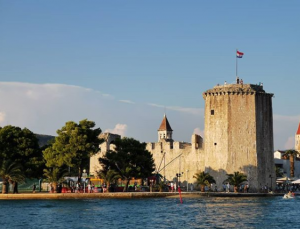
Latin Name: Tragurion
Poised delicately between mainland Dalmatia and the much larger island of Čiovo, Trogir is either a natural or artificial island, depending on who you ask. What’s not in dispute is that it’s one of Europe’s most tastefully planned towns, adhering to a grid-plan first drawn up by the ancient Greeks and substantially unchanged since then. It’s not just Trogir’s streets that have been preserved, the buildings lining them have in many cases been left undisturbed for centuries, although quite of few of them contain some of Dalmatia’s finest seafood restaurants. In addition to its inherent charms, Trogir also offers visitors in a hurry mainland Croatian’s closet counterpart to the wonderfully laid-back island towns of the Dalmatian islands.
Trogir is located on a small Island between the Island of Ciovo and the mainland, it is joined to both the mainland and the Island of Ciovo by two small bridges.
The town was first settled by the Greeks in 3BC, soon after it came under the rule of Rome and became a major port, Rome’s occupation didn’t last either after the fall of the Roman empire, in the 9th century it came under the rule of Croatian rules.
Trogir’s magnificent Romanesque-Gothic complex is arguably the best preserved in Europe, the medieval town, the cobbled narrow streets, the beautifully preserved castle and tower and the palaces from the Romanesque, Gothic, Renaissance and Baroque periods.
Trogir’s grand Romanesque-Gothic St Lawrence Cathedral is the centre piece of Trogir, built between 1213 an 1250 AD and elaborately detailed Romanesque sculptures overlooking the promenade.
The Cathedral of St James (Sv. Jakov) in Šibenik
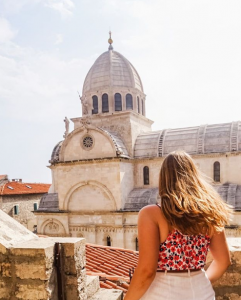
It’s appropriate that this Cathedral (built between 1431-1535) should be selected to represent “the considerable exchanges in the field of monumental arts between Northern Italy, Dalmatia and Tuscany in the 15th and 16th centuries” since Croatia as a whole has for so long served as a crossroads of cultures. The building itself illustrates the fusion between the Renaissance and Gothic styles under a series of architects, but it’s most famous for its remarkable frieze featuring 71 sculptured faces of men, women, and children. Legend has it that the extent to which these depictions flatter the local notables they’re intended to represent depends entirely on whether these individuals contributed to the building’s construction!
St James Cathedral was built between 1431 and 1535 from marble and limestone, the stone was shipped over from the Island of Brac.
Italian master builders started the Cathedral from 1431 to 1443, from 1444 until its completion in 1535 two Croatian master builders Juraj Dalmatinac and Nikola Firentinac gave the Cathedral its unique and monumental appearance.
The cathedral construction began in the Venetian Gothic style and was completed in the Toscano Renaissance style, producing a brilliant combination of the two styles.
The cathedral’s exterior was decorated with portraits of 71 prominent individuals of that time carved in stone, making the cathedral unique.
